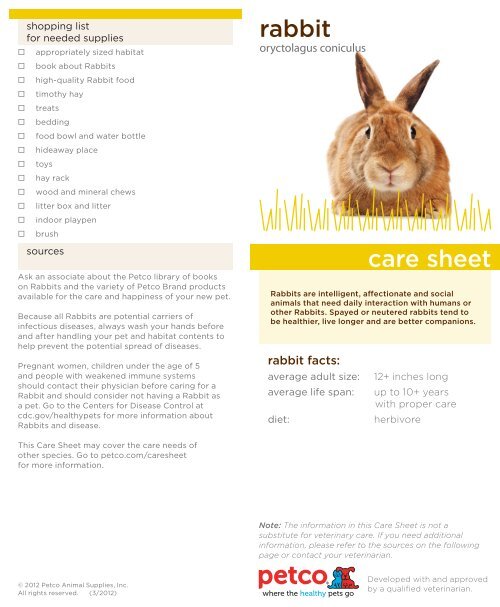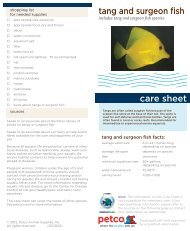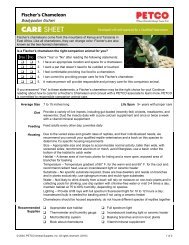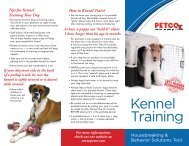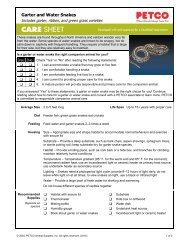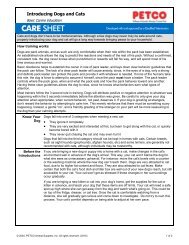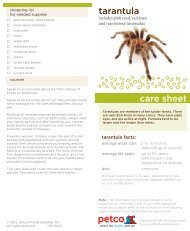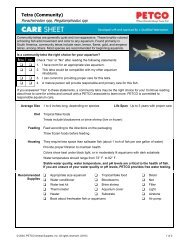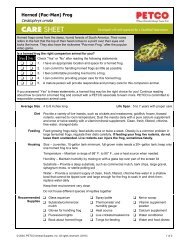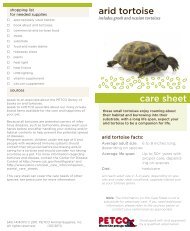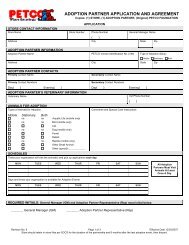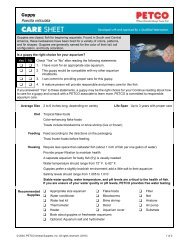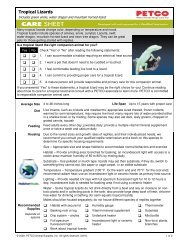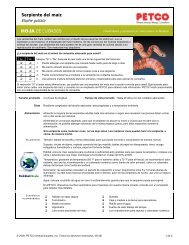Rabbit Care Sheet (PDF) - Petco
Rabbit Care Sheet (PDF) - Petco
Rabbit Care Sheet (PDF) - Petco
Create successful ePaper yourself
Turn your PDF publications into a flip-book with our unique Google optimized e-Paper software.
shopping list<br />
for needed supplies<br />
appropriately sized habitat<br />
book about <strong>Rabbit</strong>s<br />
high-quality <strong>Rabbit</strong> food<br />
timothy hay<br />
treats<br />
bedding<br />
food bowl and water bottle<br />
hideaway place<br />
toys<br />
hay rack<br />
wood and mineral chews<br />
litter box and litter<br />
indoor playpen<br />
brush<br />
sources<br />
Ask an associate about the <strong>Petco</strong> library of books<br />
on <strong>Rabbit</strong>s and the variety of <strong>Petco</strong> Brand products<br />
available for the care and happiness of your new pet.<br />
Because all <strong>Rabbit</strong>s are potential carriers of<br />
infectious diseases, always wash your hands before<br />
and after handling your pet and habitat contents to<br />
help prevent the potential spread of diseases.<br />
Pregnant women, children under the age of 5<br />
and people with weakened immune systems<br />
should contact their physician before caring for a<br />
<strong>Rabbit</strong> and should consider not having a <strong>Rabbit</strong> as<br />
a pet. Go to the Centers for Disease Control at<br />
cdc.gov/healthypets for more information about<br />
<strong>Rabbit</strong>s and disease.<br />
This <strong>Care</strong> <strong>Sheet</strong> may cover the care needs of<br />
other species. Go to petco.com/caresheet<br />
for more information.<br />
© 2012 <strong>Petco</strong> Animal Supplies, Inc.<br />
All rights reserved. (3/2012)<br />
rabbit<br />
oryctolagus coniculus<br />
care sheet<br />
<strong>Rabbit</strong>s are intelligent, affectionate and social<br />
animals that need daily interaction with humans or<br />
other <strong>Rabbit</strong>s. Spayed or neutered rabbits tend to<br />
be healthier, live longer and are better companions.<br />
rabbit facts:<br />
average adult size: 12+ inches long<br />
average life span: up to 10+ years<br />
with proper care<br />
diet: herbivore<br />
Note: The information in this <strong>Care</strong> <strong>Sheet</strong> is not a<br />
substitute for veterinary care. If you need additional<br />
information, please refer to the sources on the following<br />
page or contact your veterinarian.<br />
Developed with and approved<br />
by a qualified veterinarian.
care sheet<br />
diet<br />
The majority of a <strong>Rabbit</strong>’s diet<br />
should be composed of grass<br />
hay (any variety) which is rich in<br />
Vitamins A & D as well as calcium,<br />
protein and other nutrients. Eating<br />
hay promotes health and should be<br />
available at all times. Avoid the use<br />
of alfalfa after a <strong>Rabbit</strong> has reached<br />
approximately 7 months of age as it<br />
is very high in calcium and protein<br />
and more than a <strong>Rabbit</strong> needs.<br />
Feeding quality pellets along with<br />
hay and other green leafy<br />
vegetables is important in the<br />
rabbit’s diet to add the nutrients<br />
not readily available in hay. A wellbalanced<br />
<strong>Rabbit</strong> diet consists of:<br />
• High-quality <strong>Rabbit</strong> food,<br />
timothy hay and limited amounts<br />
of fruits and vegetables.<br />
• Clean, fresh, filtered, chlorinefree<br />
water, changed daily.<br />
Do not feed chocolate, caffeine or<br />
alcohol as these can cause serious<br />
medical conditions. Avoid sugar and<br />
high-fat treats.<br />
feeding<br />
Things to remember when feeding<br />
your <strong>Rabbit</strong>:<br />
• Fresh food, timothy hay and<br />
water should always be available.<br />
• Vegetables and fruits not eaten<br />
within several hours should be<br />
discarded.<br />
red flags<br />
• weight loss<br />
• abnormal hair loss<br />
• diarrhea or dirty bottom<br />
• distressed breathing<br />
• lethargic<br />
• eye or nasal discharge<br />
• skin lesions<br />
rabbit<br />
oryctolagus coniculus<br />
• Many house plants are toxic and<br />
a rabbit should not eat grass<br />
treated with pesticides.<br />
• Remember, treats should not<br />
exceed 10% of total food intake.<br />
• It is normal for rabbits to eat<br />
cecotropes—soft, black feces<br />
filled with minerals and nutrients<br />
(Coprophagy). This practice<br />
generally happens early in the<br />
morning which is why pet parents<br />
rarely notice.<br />
housing<br />
• <strong>Rabbit</strong>s acclimate well to average<br />
household temperatures, not<br />
to exceed 80°F. Be cautious of<br />
extreme temperature changes.<br />
The habitat should never be in<br />
direct sunlight or in a drafty area.<br />
• Habitat should be at least four<br />
times the size of the <strong>Rabbit</strong>,<br />
escape-proof with an area that<br />
has a solid surface and plenty<br />
of room for exercise and play.<br />
It is best to provide the largest<br />
habitat possible.<br />
• 1–2 inches of bedding should<br />
be placed in the habitat. Proper<br />
bedding includes high-quality<br />
paper bedding, crumbled paper<br />
bedding or hardwood shavings.<br />
Cedar-based products are not<br />
recommended.<br />
• <strong>Rabbit</strong>s may be kept in mixedsex<br />
pairs, if spayed or neutered,<br />
or same-sex pairs, if they are<br />
raised together. Otherwise, keep<br />
• overgrown teeth<br />
If you notice any of these signs, please contact your<br />
animal veterinarian.<br />
adult <strong>Rabbit</strong>s housed separately.<br />
Different types of small animals<br />
should not be housed together.<br />
normal<br />
behavior<br />
• Always exercise caution when<br />
handling a <strong>Rabbit</strong> as they do not<br />
like to be handled. Ensure you<br />
are fully supporting the body,<br />
especially the hind legs. It is best<br />
to keep them on the floor for<br />
human interaction.<br />
• <strong>Rabbit</strong>s can be litter box trained.<br />
• <strong>Rabbit</strong>s chew on objects to<br />
maintain all their teeth, which<br />
grow continuously. Ensure your<br />
<strong>Rabbit</strong> has plenty of chew sticks<br />
available.<br />
• <strong>Rabbit</strong>s can chew on apples,<br />
willow, aspen branches, pine<br />
firewood, cotton towels,<br />
untreated fresh pine lumber<br />
attached to cage, a basket with<br />
hay inside (let the rabbit chew<br />
the basket as well as the hay) and<br />
compressed alfalfa cubes.<br />
• Not all wood can be given to<br />
<strong>Rabbit</strong>s. Do not give <strong>Rabbit</strong>s<br />
apricot or peach fruit tree<br />
branches.<br />
habitat<br />
maintenance<br />
• Clean the habitat and its contents<br />
at least once a week with mild<br />
soap and water. Rinse and allow<br />
to dry completely before placing<br />
the <strong>Rabbit</strong> back into the habitat.<br />
common health issues<br />
Developed with and approved<br />
by a qualified veterinarian.<br />
• Remove wet spots daily and<br />
change bedding at least once<br />
a week, or more often as<br />
necessary.<br />
grooming<br />
& hygiene<br />
• <strong>Rabbit</strong>s stay clean and rarely<br />
need baths, but may be bathed<br />
using shampoo designed for<br />
rabbits and kittens, if necessary.<br />
Clean outside the ears frequently<br />
with a cotton ball.<br />
• It is good to brush <strong>Rabbit</strong>s<br />
regularly to remove hair that<br />
is shedding, to help prevent<br />
hairballs and to keep long-haired<br />
<strong>Rabbit</strong>s from matting. Shorthaired<br />
<strong>Rabbit</strong>s should be brushed<br />
once a week and long-haired<br />
<strong>Rabbit</strong>s can be brushed twice<br />
a week.<br />
• Consult your veterinarian if a<br />
<strong>Rabbit</strong>’s teeth or nails seem too<br />
long. Nails should be clipped<br />
often so they don’t become<br />
curled.<br />
signs of a<br />
healthy animal<br />
• Active, alert and sociable<br />
• Eats and drinks regularly<br />
• Healthy fur and clear eyes<br />
• Breathing is clear and walks<br />
normally<br />
• Communicates by making soft<br />
noises<br />
Issue Symptoms or Causes Suggested Action<br />
Diarrhea Loose stool caused by poor<br />
diet, stress, internal parasites,<br />
unclean housing or other<br />
Consult with your<br />
veterinarian to<br />
determine cause and<br />
treatment.<br />
Heat Stroke<br />
illness.<br />
Emergency condition; can Can be fatal; consult<br />
occur if rabbit is left in a hot with your veterinarian<br />
room. Symptoms include<br />
heavy panting, seizures and<br />
loss of consciousness.<br />
immediately.<br />
Malocclusion Overgrown teeth. Visit your veterinarian<br />
to have teeth<br />
trimmed regularly.<br />
Mites External parasites that cause Consult with your<br />
rabbits to lose patches of hair. veterinarian for<br />
treatment.<br />
Tumors Abnormal lumps. Consult with your<br />
veterinarian.


